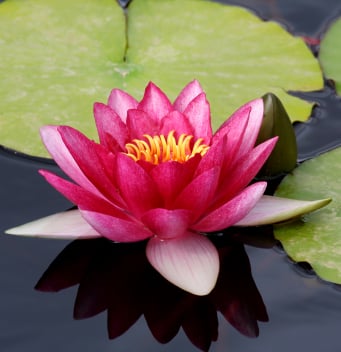Water Lilies (Nympheas)
The Water Lilies in the English section of Conservatory Garden reside in a quiet pool at the center of the flower beds. Above the placid water stands a statue sculpted by Bessie Potter Vonnoh. It commemorates “The Secret Garden”, the classic children’s book by Frances Hodgson Burnett. In mid summer this is one of the most lovely tableaus to be found anywhere in Central Park, the perfect place to while away a few moments and get away from the clattering city scene a few dozen yards away.

Water lilies
Water Lilies are also the subject of approximately 250 paintings by French Impressionist Claude Monet. Three of these paintings can be found in the Metropolitan Museum of Art, a few hundred yards away. Small world.
Botanically speaking Water Lilies are fascinating plants as well. They anchor themselves in the pond, or lake, bottom and then the flower. The Water Lily also has an interesting pollination strategy. Each white or pink flower has many petals surrounding both male and female reproductive parts, and is only open during the daytime for three days. On the first morning, the flowers produce a fluid in the cup-like center and are receptive to pollen from other flowers. However, they are not yet releasing pollen themselves. Pollen-covered insects are attracted by the sweet smell, but the flower is designed so that when they enter the flower, they fall into the fluid. This washes the pollen off their bodies and onto the female flower parts (stigmas) causing fertilization. Usually the insects manage to crawl out of the fluid and live to visit other flowers, but occasionally the unfortunate creature will remain trapped and die when the flower closes during the afternoon. On the second and the third days, the flowers are no longer receptive to pollen, and no fluid is produced. Instead, pollen is released from the stamens (the flexible yellow match-shaped structures in the flower center). Visiting insects pick up the pollen and transport it to flowers in the first day of the flowering cycle. After the three days the flowers are brought under water by coiling their stalks. The seeds mature under water and after several weeks are released into the water. Water currents or ducks, which eat the seeds, distribute them to other areas. This flowering regimen is followed nearly throughout the summer. And people think dating is difficult in the city.
 Conservatory Garden
Conservatory Garden
One of the hidden wonders of Central Park is the Conservatory Garden at Fifth Avenue and 105th St. A secluded oasis, just a few steps down from one of the City’s busiest thoroughfares; the garden offers a fragrant respite from the gasp and clatter of the urban afternoon.


